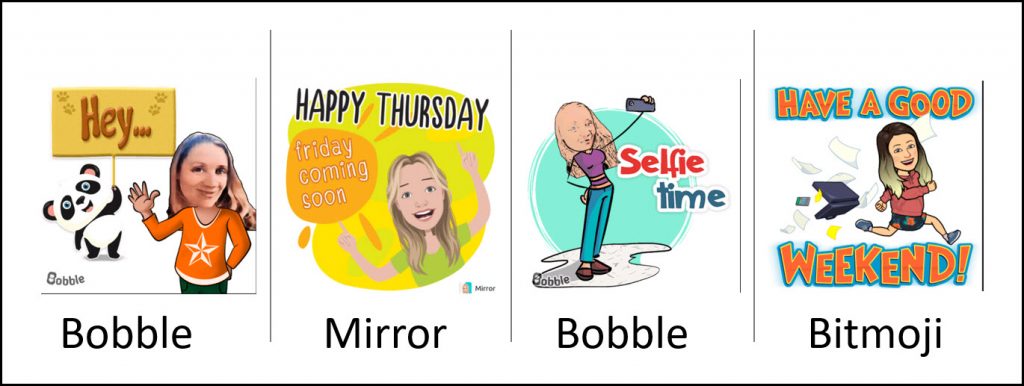Someone introduced me to Bitmoji last year, and I was impressed with how realistic (and easy) the camera-scan function was.
Bitmoji is a mobile application that allows you to create a personalized emoji. In education, it has become popular to create a Bitmoji Classroom, that can be used in a variety of ways. Over the past year I’ve created Bitmoji classrooms for online training sessions delivered over Microsoft Teams and I always have multiple requests for the slide-deck template.
Something about that little cartoon version of me seems to resonate with people and I think the appeal is due to something more than how friendly, cute and welcoming the avatar can be. At the time of posting, most of us are well aware of the phenomena called “zoom fatigue” and this past February Dee Dee Perrott shared information about Teooh, an avatar based conferencing system offering an alternative to ‘camera on’ video conferencing.
I think part of the appeal of Bitmoji, and any number of customizable avatars, is that they allow us to portray emotion and personality in digital spaces without the stresses of ‘camera on’ culture, hence allowing us to enhance communication and, in education, create more robust learning communities.
So, I was surprised not to find “Bitmoji” in the Knowledgemill yet, or much about digital avatars, which are an important method of representing self across the digital divide – from anywhere, anytime.
And I wondered two things:
- First, are there alternatives (perhaps better?) personalized emojis I could be using to help diversify my online presence as an educator and learner?
- What’s the future of digital avatars in education in training?
ANSWER 1:
I did some ‘googling’ and then I searched the Google play store on my phone and tried out several apps. promising personalized stickers/emojis/comics. Suffice to say – I was disappointed with what I found. There are A LOT out there, so perhaps there is something better, but for ease of use, customizability, and variety of “stickers” or emotions – Bitmoji is still the best that I could find. For your consideration, I present a few results below:

ANSWER 2:
As I looked around, I found research supporting the use of expressive avatars for communication, and information about avatars teaching sign-language.
But, perhaps most exciting to me, I found this article about Students teaching through virtual reality systems AND Microsoft Mesh that will “…allow geographically distributed teams to meet and collaborate in shared mixed reality sessions where participants appear as digital representations of themselves.” How exciting is that!
Microsoft Mesh has helped me envision how, in the future, little cartoon avatars may become holographic projections for collaboration. In education, I can imagine projecting avatars of our teachers and classmates into our living room via glasses/headset, and someday that headset will most certainly be replaced by objects in our smart homes and/or smaller technology interacting with our eyes and ears.

These are so fun! There are several times I’ve had to (unnecessarily, in my opinion) appear on camera for Zoom sessions that I would have preferred some digital avatar to, as it’s better than staring at a black square; I wasn’t aware that Zoom fatigue was a coined phrase for it. Apple has also stepped up their game with their own version of these, Animoji’s, that uses Apple’s facial recognition software (FaceID) to mimic a person’s facial expressions in real time as they use their character to record. I believe some models of Android phones have also started making their own versions that incorporate the use of their own facial recognition software to do the same.
Hi Tasneem,
I was trying to remember the technical phrase for ‘facial recognition’ – THANK YOU! I am really impressed by how advanced facial recognition seems to have come in a very short time. Apple is often ahead of the curve and now that I think about it, I think my friends with iPhones have been sharing Animojis in chat for quite a while. If their avatars are mimicking facial expression in real time I may have to switch to iPhone – that is phenomenal! It could really enhance the enjoyment video-conferencing.